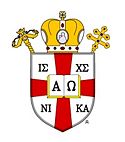Difference between revisions of "Alpha and Omega" - New World Encyclopedia
Rosie Tanabe (talk | contribs) |
|||
| (59 intermediate revisions by 4 users not shown) | |||
| Line 1: | Line 1: | ||
| − | {{ready}} | + | {{Copyedited}}{{ready}}{{Images OK}}{{submitted}}{{approved}} |
| + | [[Image:Christ-alpha-omega.jpg|200px|thumb|[[Christ]] as ''Alpha'' and ''Omega'', depicted with the ''Chi-Rho'' and Alpha-Omega symbols behind his head.]] | ||
| + | '''Alpha and Omega''' ([[Greek language|Greek]]: '''Αλφα and Ω''') is an appellation of [[God]] in the [[Book of Revelation]] (verses 1:8, 21:6, and 22:13). Its meaning is found in the fact that [[alpha (letter)|Alpha (Α)]] and [[omega (letter)|Omega (Ω)]] are respectively the first and last letters of the [[Greek alphabet]]. Twice when the phrase appears, it is clarified with the additional title "the beginning and the end" (21:6, 22:13). | ||
| − | [[ | + | Some thus see the term "Alpha and Omega" as a paraphrase of [[Isaiah]] 44:6: "I am the first and I am the last; apart from me there is no [[God]]." While the context in the Book of Revelation is clearly related to this, Jewish scholarship shows that the Alpha and Omega is also a Hellenized form of the [[rabbi]]nical dictum: "The seal of God is ''Emet'' ([[Truth]])," the word ''Emet'' (אמת) being derived the first, middle, and last letters of the [[Hebrew alphabet]]. |
| − | + | {{toc}} | |
| − | + | In the early church, the Alpha-and-Omega symbol became Christ's [[monogram]] and is still used in [[Christian art]], often in combination with the Greek letters ''Chi'' and ''Rho'', the first two letters of the word for Christ in Greek. Traditionally, the phrase is used in [[Christianity]] as evidence for [[Jesus]]' divinity and unity with [[God the Father]]. An alternative interpretation is that Christ, as the "last Adam" (1 Corinthians 15:45), represents the fulfillment of God's ideal relationship with humanity, rather than being God Himself. | |
| − | + | ==Jewish background== | |
| + | [[Image:Alfa og omega.png|thumb|left|Alpha and Omega]] | ||
| + | [[Image:Hebrew letter alef.png|thumb|150px|The Hebrew letter Aleph]] | ||
| + | [[Image:Hebrew letter tav.png|thumb|150px||The Hebrew letter Tav]] | ||
| − | + | The Hebrew for Truth is ''Emet''. It is composed of three letters: Aleph, Mem, and Tav. The Aleph and the Tav are the first and last letters of the Hebrew alphabet, equivalent to the Alpha and Omega in the [[New Testament]] scripture, which was originally written in [[Greek]]. The fact that the word ''Emet'' begins with the first letter of the alphabet and ends with the last led the ancient Jewish [[rabbi]]s to see in this word a mystical meaning. | |
| − | + | [[God]]'s absolute perfection is expressed in Isaiah 41:4 and 44:6 by the phrase, "I am the first and I am the last; apart from me there is no God." The phrase fitly expresses the idea that God is unique and eternal, the beginning and end of all that exists. As the first letter of ''Emet'', Aleph denotes that God is the first of all beings. There was no one before Him of whom He could have received the fullness of truth. The Tav, or last letter, in like manner, signifies that God is the ultimate being. There is no one higher than He, and there will be no one after Him, since He is eternal. Thus ''Emet'' is a sacred word expressing that in God, truth dwells absolutely and fully. | |
| + | In the [[Talmud]] (Yoma 69b.; Sanh. 64a.), the following is related: "The men of the great [[synagogue]] prayed to God to remove from the earth the [[yetzer harah|Evil Inclination]], as the cause of all trouble. Immediately a scroll fell from heaven with the word Truth ''(Emet)'' written on it, and a fiery lion immediately came out of the sanctuary. It was the spirit of [[idolatry]] leaving the earth." Said the ancient sage [[Rabbi Hanina]], "This legend shows that the seal of God is truth." | ||
| − | + | ==Christian usage== | |
| + | [[Image:Christogram with Jesus Prayer in Romanian.jpg|thumb|Alpha and Omega with ''Chi-Rho'' symbol within a circle containing the words of the "[[Jesus Prayer]]" of Eastern Orthodox [[Hesychasm|Hesychast]] tradition in Romanian.]] | ||
| − | ' | + | The tradition of expressing God's eternity by means of the first and last letters of the alphabet seems to have been passed down from the [[synagogue]] into the [[early church]] through the [[Book of Revelation]], generally recognized by biblical scholars as having been written by an author whose first language was either [[Hebrew]] or [[Aramaic]]. In place of the Aleph and Tav, the Alpha and Omega were substituted in the Greek text. However, the substitution of the Greek letters for those of the Hebrew tongue inevitably caused a portion of the meaning and beauty in this designation of God to be lost, for the Greek letters Alpha and Omega have no relation to the word "Truth." Although Alpha indeed happens to be the first letter of the Greek word ''aletheia'' (truth), Omega is not the last letter, as is Tav in the word Emet. In the Greek, the sacred and mystical word "Truth," expressed in Hebrew through the letters Aleph and Tav, had to be sacrificed. |
| − | + | The [[Gospel of John]], after stating that the "Word was God," (John 1:1) says, "and the Word dwelt among us full of grace and truth." (John 1:14) "Grace" here carries the idea goodness, and the phrase is virtually identical with Exodus 34:6, in which God is described as "full of goodness and truth." Thus, the writer of this verse expressed the two great divine attributes, Truth and Goodness, assigning them to Christ in all their fullness. What the [[Hebrew Bible]] had said of God, [[John the Evangelist]] thus says of Christ. | |
| + | |||
| + | [[Image:BentoXVI-44-11052007.jpg|thumb|Pope [[Benedict XVI]] pictured with an Alpha and Omega symbol]] | ||
| − | + | In the [[Book of Revelation]], the "Alpha and the Omega," represents both God (1:8, 21:6) and Christ (22:13) in different verses. This provides evidence that the book's author believed in the divinity of Christ. However, this argument has been weakened by [[textual criticism]], which reveals that the most direct reference to Jesus as the Alpha-Omega is not found in some of the earlier and best manuscripts. In traditional renderings of Revelation 1:11, it is the glorified Jesus who states: “I am Alpha and Omega, the first and the last.” However, the occurrence in 1:11 is not found in some of the oldest [[Greece|Greek]] manuscripts, including the [[Alexandrine]], [[Sinaitic]], and [[Codex Ephraemi rescriptus]]. There verse is, therefore, believed by most critical scholars to be spurious and is omitted in many modern translations.<ref>Young (1977), 179.</ref> | |
| − | + | An alternative interpretation of Jesus as the Alpha and Omega is that he represents the fulfillment of God's original ideal for the relationship between humans and God, rather that being identical with [[God the Father]]. | |
| − | In the [[ | + | ===In Christian art=== |
| + | [[Image:Arcidieceze Presov reckokat.jpg|thumb|left|125px|Crest of the Archdiocese of Presov, Slovakia]] | ||
| + | [[Image:Double Centenionalis Magnentius-XR-s4017.jpg|thumb|[[Coin]] of the Emperor [[Magnentius]], with an Alpha-Omega symbol on the reverse.]] | ||
| + | [[Image:Trinidad-Anglican-Episcopal-Coat-of-Arms.png|left|125px||thumb|The coat of arms of the Anglican diocese of [[Trinidad]]]] | ||
| − | In the [[ | + | In early Christianity, the Alpha and Omega were often used as the [[monogram]] of Christ. These letters thus became Jesus' crest. The Alpha-Omega symbol was often written under the arms of the cross within a [[circle]] or [[triangle]]. In later centuries the cross took the form of the ''[[Chi-Rho]],'' derived from the first two letters of "Christ" in [[Greek]]. Often the Alpha is found on the right and the Omega on the left, to indicate that in Christ the beginning and the end are joined into one. This crest is found on the coins of the emperors [[Constans]], [[Constantius]], and [[Magnentius]]. Since Constantius was an [[Arianism|Arian]] and thus a "[[heretic]]," this tells us that the symbol was not limited to "[[orthodoxy|orthodox]]" use. |
| − | + | Wealthier early Christians sometimes had the two letters engraved on their [[signet ring]]s, confirming the Jewish concept (whether consciously or not) of the Truth (which the Christians believed to be incarnate in [[Jesus]]) as the "seal of God." Sometimes the Alpha and the Omega are written in the [[nimbus]], or [[halo]], of Jesus as the Lamb of ''Revelation''. Examples of the Alpha and Omega in Christian art include the paintings in the catacombs of [[Peter and Marcellinus]] in the third century, as well as the [[fresco]]es and [[mosaic]]s of several ancient churches, including the chapel of [[Saint Felicitas]] and [[Saint Mark]]'s church in Rome, and the mosaics of [[Ravenna]]. | |
| − | |||
| + | In the course of time, the Alpha and Omega ceased to be used as the monogram of Christ for church paintings and ornaments in Catholic tradition, although in recent years it has begun to reappear. It is also used in Orthodox [[icon]]ography and has also found popularity in Anglican and other Protestant traditions. The symbol can often be found on many Christian tombstones. | ||
| − | + | More recently, the Alpha and Omega has been used as a [[logo]] on Christian tee-shirts and baseball caps, and has also been adopted by various mystical and [[neo-paganism|neo-pagan traditions]], symbolizing the unity between God and humans. [[Tattoo]] artists often include the symbol in their repertoires, and it has also been used as the logo for various businesses and the title of several [[rock and roll]] albums and bands. | |
| − | |||
| − | |||
| − | |||
| − | |||
| − | |||
| − | |||
==Notes== | ==Notes== | ||
<references /> | <references /> | ||
| + | |||
| + | ==References== | ||
| + | * Barclay, William. ''Jesus As They Saw Him; New Testament Interpretations of Jesus''. New York: Harper & Row, 1962. OCLC 1235361 | ||
| + | * J. Paul Getty Museum. ''Alpha and Omega: Visions of the Millennium''. Los Angeles, Calif: J. Paul Getty Museum, 1999. ISBN 9780892365760 | ||
| + | * Jennings, Samuel W.'' Alpha and Omega: Studies in the Book of Revelation''. Greenville, S.C.: Ambassador, 1996. ISBN 9781898787778 | ||
| + | * Jenson, Robert W. ''Alpha and Omega; a Study in the Theology of Karl Barth''. New York: Nelson, 1963. OCLC 1424755 | ||
| + | * Jevtic, Atanasije. ''Christ, the Alpha and Omega''. Alhambra, Calif: Serbian Orthodox Diocese of Western America, 2007. ISBN 9780971950528 | ||
| + | * Young, Robert. ''Concise Commentary on the Holy Bible: Being a Companion to the New Translation of the Old and New Covenants''. Grand Rapids: Baker Book House, 1977. OCLC 5975522 | ||
==External links== | ==External links== | ||
| − | *[http://www.newadvent.org/cathen/01332a.htm Catholic Encyclopedia | + | All links retrieved July 23, 2023. |
| − | *[http://www.jewishencyclopedia.com/view.jsp?artid=1307&letter=A Jewish Encyclopedia | + | |
| + | *[http://www.newadvent.org/cathen/01332a.htm Alpha and Omega (in Scripture)] ''Catholic Encyclopedia'' | ||
| + | *[http://www.jewishencyclopedia.com/view.jsp?artid=1307&letter=A Alpha and Omega] ''Jewish Encyclopedia'' | ||
[[Category:Philosophy and religion]] | [[Category:Philosophy and religion]] | ||
[[Category:Religion]] | [[Category:Religion]] | ||
| − | |||
{{credits|Alpha_and_Omega|153907479}} | {{credits|Alpha_and_Omega|153907479}} | ||
Latest revision as of 08:22, 23 July 2023
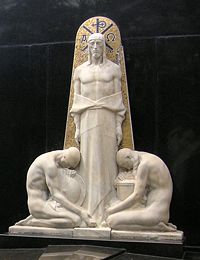
Alpha and Omega (Greek: Αλφα and Ω) is an appellation of God in the Book of Revelation (verses 1:8, 21:6, and 22:13). Its meaning is found in the fact that Alpha (Α) and Omega (Ω) are respectively the first and last letters of the Greek alphabet. Twice when the phrase appears, it is clarified with the additional title "the beginning and the end" (21:6, 22:13).
Some thus see the term "Alpha and Omega" as a paraphrase of Isaiah 44:6: "I am the first and I am the last; apart from me there is no God." While the context in the Book of Revelation is clearly related to this, Jewish scholarship shows that the Alpha and Omega is also a Hellenized form of the rabbinical dictum: "The seal of God is Emet (Truth)," the word Emet (אמת) being derived the first, middle, and last letters of the Hebrew alphabet.
In the early church, the Alpha-and-Omega symbol became Christ's monogram and is still used in Christian art, often in combination with the Greek letters Chi and Rho, the first two letters of the word for Christ in Greek. Traditionally, the phrase is used in Christianity as evidence for Jesus' divinity and unity with God the Father. An alternative interpretation is that Christ, as the "last Adam" (1 Corinthians 15:45), represents the fulfillment of God's ideal relationship with humanity, rather than being God Himself.
Jewish background
The Hebrew for Truth is Emet. It is composed of three letters: Aleph, Mem, and Tav. The Aleph and the Tav are the first and last letters of the Hebrew alphabet, equivalent to the Alpha and Omega in the New Testament scripture, which was originally written in Greek. The fact that the word Emet begins with the first letter of the alphabet and ends with the last led the ancient Jewish rabbis to see in this word a mystical meaning.
God's absolute perfection is expressed in Isaiah 41:4 and 44:6 by the phrase, "I am the first and I am the last; apart from me there is no God." The phrase fitly expresses the idea that God is unique and eternal, the beginning and end of all that exists. As the first letter of Emet, Aleph denotes that God is the first of all beings. There was no one before Him of whom He could have received the fullness of truth. The Tav, or last letter, in like manner, signifies that God is the ultimate being. There is no one higher than He, and there will be no one after Him, since He is eternal. Thus Emet is a sacred word expressing that in God, truth dwells absolutely and fully.
In the Talmud (Yoma 69b.; Sanh. 64a.), the following is related: "The men of the great synagogue prayed to God to remove from the earth the Evil Inclination, as the cause of all trouble. Immediately a scroll fell from heaven with the word Truth (Emet) written on it, and a fiery lion immediately came out of the sanctuary. It was the spirit of idolatry leaving the earth." Said the ancient sage Rabbi Hanina, "This legend shows that the seal of God is truth."
Christian usage
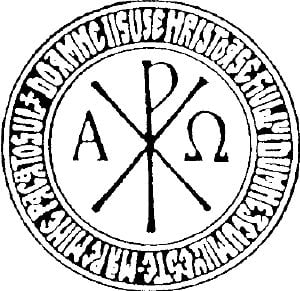
The tradition of expressing God's eternity by means of the first and last letters of the alphabet seems to have been passed down from the synagogue into the early church through the Book of Revelation, generally recognized by biblical scholars as having been written by an author whose first language was either Hebrew or Aramaic. In place of the Aleph and Tav, the Alpha and Omega were substituted in the Greek text. However, the substitution of the Greek letters for those of the Hebrew tongue inevitably caused a portion of the meaning and beauty in this designation of God to be lost, for the Greek letters Alpha and Omega have no relation to the word "Truth." Although Alpha indeed happens to be the first letter of the Greek word aletheia (truth), Omega is not the last letter, as is Tav in the word Emet. In the Greek, the sacred and mystical word "Truth," expressed in Hebrew through the letters Aleph and Tav, had to be sacrificed.
The Gospel of John, after stating that the "Word was God," (John 1:1) says, "and the Word dwelt among us full of grace and truth." (John 1:14) "Grace" here carries the idea goodness, and the phrase is virtually identical with Exodus 34:6, in which God is described as "full of goodness and truth." Thus, the writer of this verse expressed the two great divine attributes, Truth and Goodness, assigning them to Christ in all their fullness. What the Hebrew Bible had said of God, John the Evangelist thus says of Christ.
In the Book of Revelation, the "Alpha and the Omega," represents both God (1:8, 21:6) and Christ (22:13) in different verses. This provides evidence that the book's author believed in the divinity of Christ. However, this argument has been weakened by textual criticism, which reveals that the most direct reference to Jesus as the Alpha-Omega is not found in some of the earlier and best manuscripts. In traditional renderings of Revelation 1:11, it is the glorified Jesus who states: “I am Alpha and Omega, the first and the last.” However, the occurrence in 1:11 is not found in some of the oldest Greek manuscripts, including the Alexandrine, Sinaitic, and Codex Ephraemi rescriptus. There verse is, therefore, believed by most critical scholars to be spurious and is omitted in many modern translations.[1]
An alternative interpretation of Jesus as the Alpha and Omega is that he represents the fulfillment of God's original ideal for the relationship between humans and God, rather that being identical with God the Father.
In Christian art
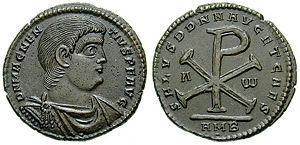
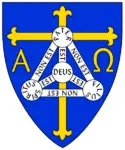
In early Christianity, the Alpha and Omega were often used as the monogram of Christ. These letters thus became Jesus' crest. The Alpha-Omega symbol was often written under the arms of the cross within a circle or triangle. In later centuries the cross took the form of the Chi-Rho, derived from the first two letters of "Christ" in Greek. Often the Alpha is found on the right and the Omega on the left, to indicate that in Christ the beginning and the end are joined into one. This crest is found on the coins of the emperors Constans, Constantius, and Magnentius. Since Constantius was an Arian and thus a "heretic," this tells us that the symbol was not limited to "orthodox" use.
Wealthier early Christians sometimes had the two letters engraved on their signet rings, confirming the Jewish concept (whether consciously or not) of the Truth (which the Christians believed to be incarnate in Jesus) as the "seal of God." Sometimes the Alpha and the Omega are written in the nimbus, or halo, of Jesus as the Lamb of Revelation. Examples of the Alpha and Omega in Christian art include the paintings in the catacombs of Peter and Marcellinus in the third century, as well as the frescoes and mosaics of several ancient churches, including the chapel of Saint Felicitas and Saint Mark's church in Rome, and the mosaics of Ravenna.
In the course of time, the Alpha and Omega ceased to be used as the monogram of Christ for church paintings and ornaments in Catholic tradition, although in recent years it has begun to reappear. It is also used in Orthodox iconography and has also found popularity in Anglican and other Protestant traditions. The symbol can often be found on many Christian tombstones.
More recently, the Alpha and Omega has been used as a logo on Christian tee-shirts and baseball caps, and has also been adopted by various mystical and neo-pagan traditions, symbolizing the unity between God and humans. Tattoo artists often include the symbol in their repertoires, and it has also been used as the logo for various businesses and the title of several rock and roll albums and bands.
Notes
- ↑ Young (1977), 179.
ReferencesISBN links support NWE through referral fees
- Barclay, William. Jesus As They Saw Him; New Testament Interpretations of Jesus. New York: Harper & Row, 1962. OCLC 1235361
- J. Paul Getty Museum. Alpha and Omega: Visions of the Millennium. Los Angeles, Calif: J. Paul Getty Museum, 1999. ISBN 9780892365760
- Jennings, Samuel W. Alpha and Omega: Studies in the Book of Revelation. Greenville, S.C.: Ambassador, 1996. ISBN 9781898787778
- Jenson, Robert W. Alpha and Omega; a Study in the Theology of Karl Barth. New York: Nelson, 1963. OCLC 1424755
- Jevtic, Atanasije. Christ, the Alpha and Omega. Alhambra, Calif: Serbian Orthodox Diocese of Western America, 2007. ISBN 9780971950528
- Young, Robert. Concise Commentary on the Holy Bible: Being a Companion to the New Translation of the Old and New Covenants. Grand Rapids: Baker Book House, 1977. OCLC 5975522
External links
All links retrieved July 23, 2023.
- Alpha and Omega (in Scripture) Catholic Encyclopedia
- Alpha and Omega Jewish Encyclopedia
Credits
New World Encyclopedia writers and editors rewrote and completed the Wikipedia article in accordance with New World Encyclopedia standards. This article abides by terms of the Creative Commons CC-by-sa 3.0 License (CC-by-sa), which may be used and disseminated with proper attribution. Credit is due under the terms of this license that can reference both the New World Encyclopedia contributors and the selfless volunteer contributors of the Wikimedia Foundation. To cite this article click here for a list of acceptable citing formats.The history of earlier contributions by wikipedians is accessible to researchers here:
The history of this article since it was imported to New World Encyclopedia:
Note: Some restrictions may apply to use of individual images which are separately licensed.




